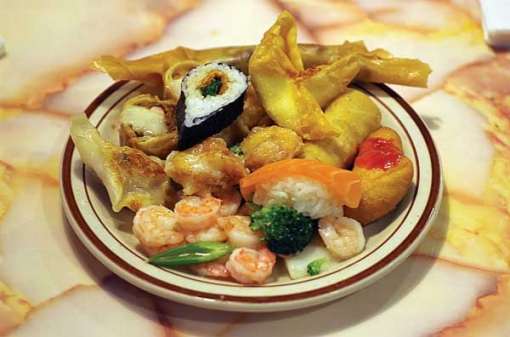Over Thanksgiving weekend,
the hashtag #AsianThanksgiving blew up on Twitter, offering a delicious peek at
dinner tables across Asian America: turkey congee, kimchi stuffing, soy sauce
gravy, and that old reliable day-after-Thanksgiving staple, turkey fried rice.
Asian Thanksgivings were by no means limited to home cooking, of course -- the
Irish owner of our local pub told us that she and her party devoured several
birds at Sun Wah BBQ, the neighborhood Beijing duck joint.
As for our family,
we spent Thanksgiving at the same place we’d spent the last five: at
Super China Buffet, located in a strip mall on the Western outskirts of
Chicago. As in previous years, the place was packed with first- and
second-generation families from all over, for whom the American traditions of
the Thanksgiving table hadn’t necessarily taken root in the home.
Instead, everyone found comfort and family cheer gathered around the steaming
food trays of the all-you-can-eat Chinese buffet. Old folks and young
folks from Asia, Africa, Eastern Europe, and Latin America jostling over
heaping piles of crab rangoons, sushi, cheese mussels, mashed potatoes,
macaroni, and Jello -- what could be more American than that?
If the takeout formula of Chinese food has long been integral to the
American gastronomic landscape, then the all-you-can-eat Chinese buffet
simply represents the utilitarian values of Chinese fast food taken to
their logical extremes. The buffet is by no means an American
invention, though its current all-you-can-eat incarnation purportedly arrived on the scene
in the 1940s in (where else?) Las Vegas, where a local publicist named
Herb McDonald came up with the $1 “Buckaroo Buffet” to feed hungry
gamblers at El Rancho Vegas.
It's unclear when and where the first Chinese buffet popped up in the States -- in the Fortune Cookie Chronicles, Jennifer
8. Lee suggested that it was popularized in the Midwest and the South
by a recent wave of immigrants from Fujian province in China, while
Betty Xie, editor-in-chief of the industry standard Chinese Restaurant News, told food critic Steven A. Shaw in Asian Dining Rules that
they originated in Canada before moving to New York and then taking
over 10% of the American Chinese restaurant industry. In any case, the
Chinese buffet's stunning success as a business model makes perfect
sense. Both buffets and Chinese takeout operate on the same
principles: they're fast, cheap, and filling. Combine the two and you
get...all-you-can-eat egg rolls? Freaking brilliant.
And even more than your
neighborhood Chinese takeout that might offer maki rolls, pad Thai, or the
occasional burger and fries, Chinese buffets can skillfully adapt themselves to
local needs and tastes due to the flexibility of the open buffet layout.
A quick glance at three Chicago-area buffet restaurants reveals predictable yet
still intriguing differences in admission prices, food options, and clientele.
Buffet Castle, located in the largely blue-collar Latino neighborhood of
Avondale in Chicago, costs $9.50 for one adult and offers cheese-smothered
pizza, burritos, tacos, and taquitos in addition to the typical fried Chinese
takeout fare. In contrast, the spectacular Royal Hibachi Sushi Seafood Buffet
in the suburb of Hoffman Estates, which can cost up to $27 per person on
Lobster Night, offers remarkably fresh sushi and sashimi, a smorgasbord of
shellfish, a swanky cocktail bar, and a giant whirring cotton candy machine;
well-dressed Asian suburbanites sweep through in Meetup groups, where they line
up before the koi pond at the entrance.
Our family’s favorite, Super
China Buffet, charges $11.99 and, like its price, falls somewhere in between
the other two buffets in the range of its offerings, including a variety of
sushi, dim sum, Korean-style pan-fried fish, and Mongolian BBQ. Situated
in the mostly white suburb of Norridge with its large Polish immigrant population across the street from one of the most
bustling malls in the Chicago area, Super China Buffet serves diners whose demographics
shift dramatically depending on the day. During non-holidays, the
restaurant is notably less diverse. During Thanksgiving weekend and Christmas,
though, as my husband puts it: “It’s like the UN in here!”
It's frequently noted that
Chinese restaurants in America during the last century have served as spaces
where other immigrant groups learned to define themselves as Americans. The
unique relationship between Jews and Chinese food has been well documented (and
endlessly joked about, especially around the holidays), but other immigrant
groups quickly caught on to the merits of chop suey, too. As Dawn Bohulano
Mabalon writes in the recent volume Eating Asian America: A Food Studies
Reader, for Filipinas/os of her parents’ generation, “going out for Chinese
food was an important symbol of their Americanization."
Of course, however, the
American Chinese restaurant -- and especially the sprawling chaos of the Chinese
buffet -- has never been an entirely neutral gathering place. While
immigrants may feel more “American” amid such welcoming environments, more
fully assimilated and aspirationally minded Americans often feel disdain
towards their populist all-inclusiveness. The negative Yelp reviews of Super
China Buffet, marked by their (classist) foodie sensibilities and English
fluency, are decidedly not written by immigrants who go there for
Thanksgiving. As one Asian American woman complains: “The clientele?
Gypsys, Tramps, and Thieves. That is all that I will say.
Okay...one more comes to mind..douchebags…I hereby turn in my Asian card
[sic].”
Now, if my dad could write a
Yelp review of Super China Buffet, he would simply say: “Good variety, good
value!” (Which are pretty much his exact words every time, except in
Korean.) And while it seems obvious, two separate academic studies of Chinese buffets
(yes they exist, though sadly I couldn’t find any more recent than 2003) indeed
scientifically confirm that these are the two most common reasons why folks
keep returning to these establishments. An interesting sub-point is that people
insist they don’t go to Chinese buffets for an “exotic” dining
experience, which is usually why customers seek out so-called ethnic
restaurants. In fact, according to the 2003 study, this reason ranked dead last
in the survey.
But maybe it's the very fact that Chinese buffets are
totally not about exoticized “authenticity,” and that the food
is generic, predictable, and stubbornly resistant to culinary innovation, that
make these restaurants so comforting -- and in a way, as American as McDonald's
-- to many immigrant diners. Added to all this, too, I suspect that the
potentially infinite promise of food is an irresistible draw for those like my
parents who’ve endured wartime poverty and hunger at some point in their
lives. That’s why I try not to judge -- at least not too much -- when my
folks insist on getting up one more time for that seventh plate of sushi, shrimp, and soft-serve ice cream. (You know what I'm talking about.)

Image credit: Chris Busby at TheBollard.com.
There may be a high price to
pay for such cheap abundance, though. Chinese buffet workers, often
undocumented and lacking in the language and legal resources needed to
challenge unfair labor practices, are frequently the biggest victims of the
low-cost Chinese buffet system. Many stories of exploitation of Chinese buffet workers across the
US have been reported in the past decade, including in Chicago, where the owners of fourteen Chinese
buffets were sued in 2002 by the U.S. and Illinois Departments of Labor for
$1.5 million in unpaid back wages to their employees. In a horrific recent case in Countryside, Florida,
the owners of a popular buffet restaurant were sentenced for “harboring,
transporting, and exploiting illegal aliens” following a two-year investigation
by Homeland Security that found the restaurant's twenty-seven employees living
together in three cramped apartment units and working eighteen hour days, six
days a week at a rate of $3 an hour.
But the fact that such cases
are coming to light, together with this year’s closing of the popular Saigon Grill
takeout restaurant in New York, the result of a years-long legal and financial
battle that began in 2007 with its delivery workers going on strike, offers
both a cautionary tale for Asian restaurant owners and encouragement for
immigrant restaurant workers everywhere. Perhaps, then, the huge Chinese buffet
industry offers the potential to foreground yet another transformational
American narrative -- the ongoing story of restaurant workers claiming
their rightful place, through collective bargaining and legal action, in the
mainstream economy of America.
At present, the
all-you-can-eat Chinese buffet is an all-American institution in the
consumer-driven mold of Walmart, offering low prices and a huge variety to
appeal to the greatest number of people. (Oh yes, and both tend to be open on Thanksgiving.) But it's only when all of
its workers are paid and treated fairly that Chinese buffet restaurants will really
start resembling the American dream, both behind and in front of the glittering
buffet aisles.









Comments